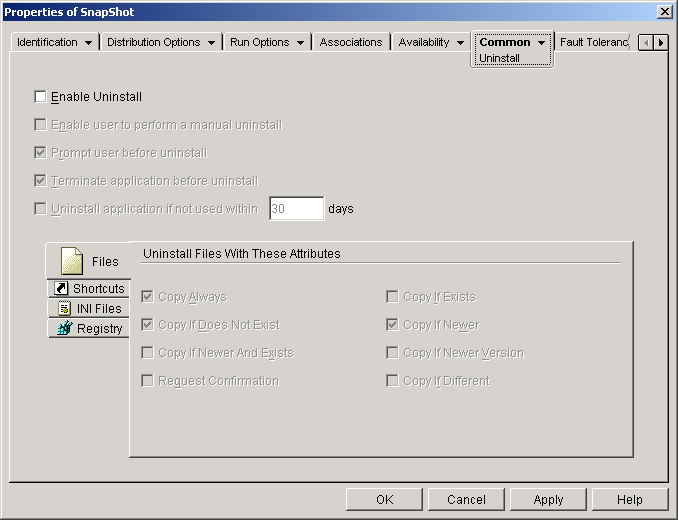In ConsoleOne®, right-click the Application object > click Properties.
Click the Common tab > Uninstall to display the Uninstall page.

Click the Enable Uninstall box to turn on the option.
If you want users to be able to uninstall the application themselves, click the Enable User to Perform a Manual Uninstall to turn on the option.
For information about how users can uninstall the application, see Using Application Launcher/Explorer to Uninstall an Application .
Set the other Uninstall options as appropriate:
Prompt User Before Uninstall: Select this option to prompt users before removing the application from their workstations. If users answer "No" to the prompt, the application will not be removed.
Terminate Application Before Uninstall: Select this option to ensure that Application Launcher/Explorer terminates the application (if the application is running) before it begins uninstalling the application files.
Uninstall Application If Not Used Within XX Days: Select this option to automatically remove the application if the user has not run it within the specified number of days (the default is 30). For more information, see Uninstalling Unused Applications .
Select the attributes you want used when determining whether or not to uninstall files, shortcuts, INI settings, and registry settings.
Files: Click Files > check the attributes you want to use to determine whether or not an application file is removed. The attributes correspond to the attributes listed on the Application Files page (Distribution Options tab). By default, the options are configured (Copy Always, Copy if Does Not Exist, Copy if Newer) to ensure that a file is removed only if it was installed when the application was installed and not at an earlier time by another application that also needs the file.
Shortcuts: Click Shortcuts > check the attributes you want to use to determine whether or not the application's shortcuts are removed. The attributes correspond to the attributes listed on the Shortcuts/Icons page (Distribution Options tab).
INI Files: Click INI Files > check the attributes you want to use to determine whether or not an INI setting is removed. The attributes correspond to the attributes listed on the INI Settings page (Distribution Options tab). By default, the options are configured (Create Always, Create if Exists, Create or Add to Existing Section) to ensure that a setting is removed only if it was created when the application was installed and not at an earlier time by another application that also needs the setting.
Registry: Click Registry > check the attributes you want to use to determine whether or not a registry setting is removed. The attributes correspond to the attributes listed on the Registry Settings page (Distribution Options tab). By default, the options are configured (Create Always, Create if Exists) to ensure that a setting is removed only if it was created when the application was installed and not at an earlier time by another application that still needs the setting.
The Uninstall Keys/Values From These Registry Hives option allows you to select two specific registry hives, HKEY_LOCAL_MACHINE and HKEY_CURRENT_USER, to include or exclude when removing the registry settings that were added by Application Launcher/Explorer during distribution of the application to the workstation. The default settings cause Application Launcher/Explorer to remove settings from the HKEY_CURRENT_USER hive but not from the HKEY_LOCAL_MACHINE hive.
The purpose of this option is to help you ensure that no Windows* system settings are removed during the uninstall. This is particularly important if you used snAppShotTM to capture the application's installation. When snAppShot captures an application's installation, it includes all settings that are changed during the installation. If the application's installation program causes the workstation to reboot during the installation process, these changes can include not only settings that apply to the application but also settings that apply to the Windows system. Removing Windows system settings may cause the workstation to encounter problems when starting up. It is strongly recommended that you remove these settings only if you are positive that they will not affect the workstation's ability to function properly.
NOTE: If you want to use this option, you should examine the registry settings that will be removed from the HKEY_LOCAL_MACHINE and HKEY_CURRENT_USER hives and delete any settings that apply to anything other than the application. The registry settings are displayed on the Registry Settings page (Distribution Options tab).
Click OK to save the changes.